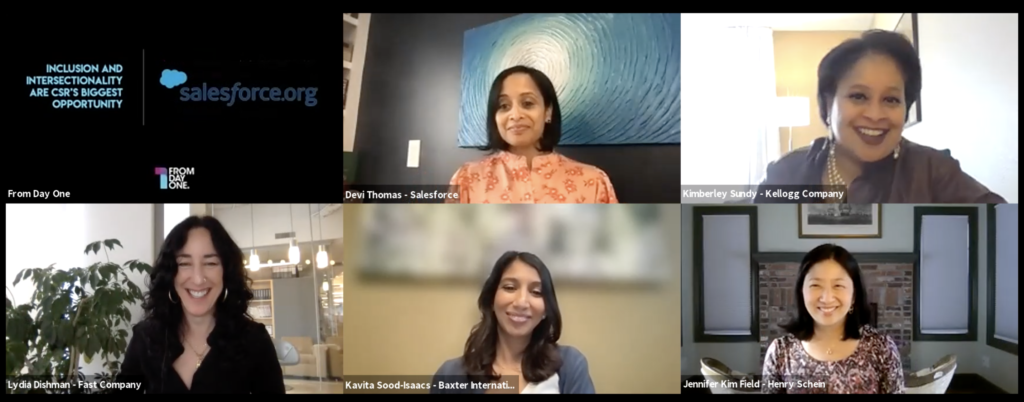How Diversity and Social Impact Can Work Together


Traditionally, companies split the work of corporate social responsibility, or CSR, from their initiatives toward diversity, equity, and inclusion. CSR was considered external affairs, while DEI was largely internal. But as the pandemic and social-justice movement shook up many past corporate norms, this relationship is changing at some of the largest companies in the world.
“We’ve started looking at terms like equity and inclusion in a very different way, spurred by the multi-crisis environment we were in,” said Devi Thomas, the VP of social-impact marketing and insights for Salesforce.org. “If we look at equity, we realize problem solving doesn’t just belong to philanthropists–it belongs to everyone.”
Thomas took part in a recent From Day One webinar, moderated by Fast Company staff editor Lydia Dishman, to talk about the increasingly intersectional relationship between corporate culture, philanthropy, governance, and impact. CSR, the panelists pointed out, cannot be effective without community leadership and inclusion. In their conversation, they spoke about how their companies are forging a path according to new models.
“Intersectionality and collaboration are the trends you’re seeing,” said Jennifer Kim Field, VP of CSR and director of the company foundation at Henry Schein, a worldwide distributor of health care products. The company started a D&I Council last year to address the issue under four tenets: talent, culture, marketplace, and society. “In that society bucket is where you’re seeing [the company] connect more, and ensure employees are being heard in how they want to support communities,” she said.
When it comes to making these changes, panelists stressed that they should be employee-driven with full leadership buy-in. At Baxter International, a maker of health-care products and therapies, the company worked with the Baxter Black Alliance to develop ACT: Activating Change Today, a multiyear initiative to advance inclusion and racial justice.
“It was really employee-driven when it came to looking at a solution that would work for all our different stakeholders and communities, and it started at the top,” said Kavita Sood-Isaacs, Baxter’s senior manager for global community relations.
At Henry Schein, all senior leaders were evaluated with a DEI goal tied to their bonus. “We’re going to hold ourselves accountable for what it means to be an inclusive company,” said Kim Field.

At the Kellogg Co., “we recognized that solutions came from everywhere and could come from everywhere,” said Kimberley Sundy, senior director of sustainability. The company worked with its African-American Resource Group, which was concerned with food insecurity in Black and brown communities and contributed ideas for the company’s CSR programs.
The panelists stressed the value of collaborating with employee resource groups (ERGs). “In my experience the role of the ERG is elevated within the context of the corporation,” said Thomas. Baxter increased its commitment to $50,000 for a two-year grant to each of its ERGs, “so they can really look at their communities and find the issues important to them as a group,” said Sood-Isaacs. At Kellogg’s, the company observed Hispanic Heritage Month by working with its Hispanic ERG to develop special Pop-Tarts designs to celebrate the holiday of Día de los Muertos. “I think we have a bigger appetite for risk now,” said Sundy.
Companies are also forging new external partnerships, including ties with HBCUs and community organizations. “It really needs to stem from authenticity as far as what groups and issues matter to you as a company–we can’t all tackle the issue from every angle, but we can look at it from the priorities that matter to us,” said Sood-Isaacs. At Kellogg’s, the chief executive determined four pillars of community priority, “so our partnerships line up against that materiality,” said Sundy.
The speakers shared techniques to break down organizational silos. Salesforce.org now assigns “inclusive hiring partners” to leadership to help make the job-application process more equitable. “It’s made a difference in the way my team looks, acts and feels,” Thomas said. Kim Field shared straightforward advice: “Just have a conversation–everything doesn’t have to come from the top down,” she said. “To get that internal supporter is huge and it doesn’t have to come from your boss. Just start having the dialogue and you’ll be surprised where you might find that hidden gem willing to come along the journey with you.”
Emily Nonko is a Brooklyn, NY-based reporter who writes about real estate, architecture, urbanism and design. Her work has appeared in the Wall Street Journal, New York magazine, Curbed and other publications.
The From Day One Newsletter is a monthly roundup of articles, features, and editorials on innovative ways for companies to forge stronger relationships with their employees, customers, and communities.